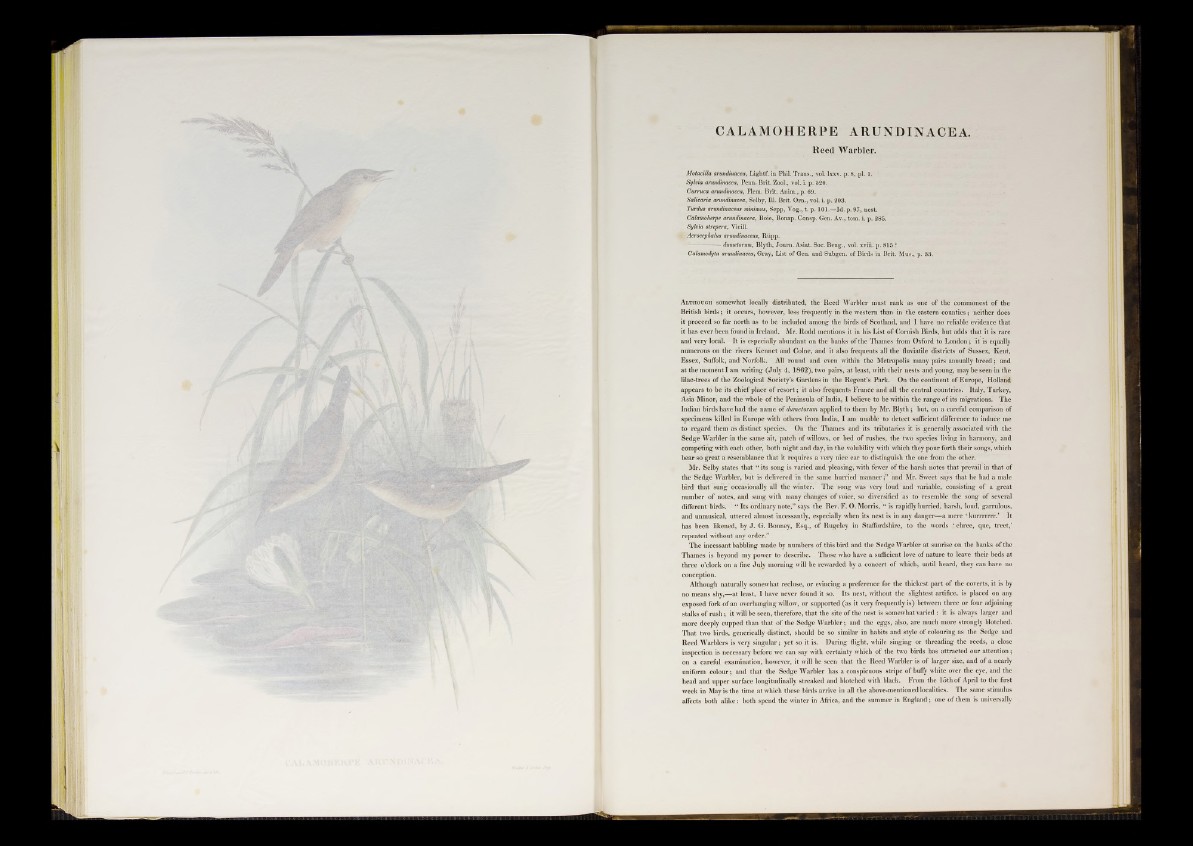
CALAMOHERPE ARUNDINACEA.
Heed Warbler.
Motacilla arundinacea, Lightf. in Phil. Trans., vol. lxxv. p: 8, pi. 1.
Sylvia arundinacea, Penn. Brit. Zool., vol. i. p. 520.
Curruca arundinacea, Flem. Brit. Anim., p. 69.
Salicaria arundinacea, Selby, 111. Brit. Om., vol. i. p. 203.
Turdus arundinaceus minimus, Sepp, Vog., t. p. 101.—Id. p. 97, nest.
Caldmoherpe arundinacea, Boie, Bonap. Consp. Gen. Av., tom. i. p. 285.
Sylvia streperà, Vieill.
Acrocephalus arundinaceus, Riipp.
dumetorum, Blyth, Journ. Asiat. Soc. Beng., vol. xviii. p. 815 ?
Calamodyta arundinacea, Gray, List of Gen. and Subgen. of Birds in Brit. Mus., p. 33.
A lthough somewhat locally distributed, the Reed Warbler must rank as one of the commonest of the
British birds; it occurs, however, less frequently in the western than in the eastern counties; neither does
it proceed so far north as to be included among the birds of Scotland, and I have no reliable evidence that
it has ever been found in Ireland. Mr. Rodd mentions it in his List of Cornish Birds, but adds that it is rare
and very local. It is especially abundant on the banks of the Thames from Oxford to London; it is equally
numerous on the rivers Kennet and Colne, and it also frequents all the fluviatile districts of Sussex, Kent,
Essex, Suffolk, and Norfolk. All round and even within the Metropolis many pairs annually breed; and
at the moment I am writing (July 4, 1862), two pairs, at least, with their nests and young, may be seen in the
lilac-trees of the Zoological Society’s Gardens in the Regent’s Park. On the continent of Europe, Holland
appears to be its chief place of resort; it also frequents France and all the central countries. Italy, Turkey,
Asia Minor, and the whole of the Peninsula of India, I believe to be within the range of its migrations. The
Indian birds have had the name of dumetorum applied to them by Mr. Blyth; but, on a careful comparison of
specimens killed in Europe with others from India, I am uuable to detect sufficient difference to induce me
to regard them as distinct species. On the Thames and its tributaries it is generally associated with the
Sedge Warbler in the same ait, patch of willows, or bed of rushes, the two species living in harmony, and
competing with each other, both night and day, in the volubility with which they pour forth their songs, which
bear so great a resemblance that it requires a very nice ear to distinguish the one from the other.
Mr. Selby states that “ its song is varied and pleasing, with fewer of the harsh notes that prevail in that of
the Sedge Warbler, but is delivered in the same hurried ma n n e r a n d Mr. Sweet says that he had a male
bird that sung occasionally all the winter. The song was very loud and variable, consisting of a great
number of notes, and sung with many changes of voice, so diversified as to resemble the song of several
different birds. “ Its ordinary note,” says the Rev. F. O. Morris, “ is rapidly hurried, harsh, loud, garrulous,
and unmusical, uttered almost incessantly, especially when its nest is in any danger—a mere ‘ kurrrrrrr.’ It
has been likened, by J . G. Bonney, Esq., of Rugeley in Staffordshire, to the words ‘ chree, que, treet,’
repeated without any order.”
The incessant babbling made by numbers of this bird and the Sedge Warbler at sunrise on the banks of the
Thames is beyond my power to describe. Those who have a sufficient love of nature to leave their beds at
three o’clock on a fine July morning will be rewarded by a concert of which, until heard, they can have no
conception.
Although naturally somewhat recluse, or evincing a preference for the thickest part of the coverts, it is by
no means shy,—a t least, I have never found it so. Its nest, without the slightest artifice, is placed on any
exposed fork of an overhanging willow, or supported (as it very frequently is) between three or four adjoining
stalks o f ru sh ; it will be seen, therefore, that the site o f the nest is somewhat varied: it is always larger and
more deeply cupped than that of the Sedge Warbler; and the eggs, also, are much more strongly blotched.
That two birds, generically distinct, should be so similar in habits and style of colouring as the Sedge and
Reed Warblers is very singular; yet so it is. During flight, while singing or threading the reeds, a close
inspection is necessary before we can say with certainty which of the two birds has attracted our attention;
on a careful examination, however, it will be seen that the Reed Warbler is of larger size, and of a nearly
uniform colour; and that, the Sedge Warbler has a conspicuous stripe of buffy white over the eye, and the
head and upper surface longitudinally streaked and blotched with black. From the 15th of April to the first
week in May is the time at which these birds arrive in all the above-mentioned localities. The same stimulus
affects both alike: both spend the winter in Africa, and the summer in England; one of them is universally